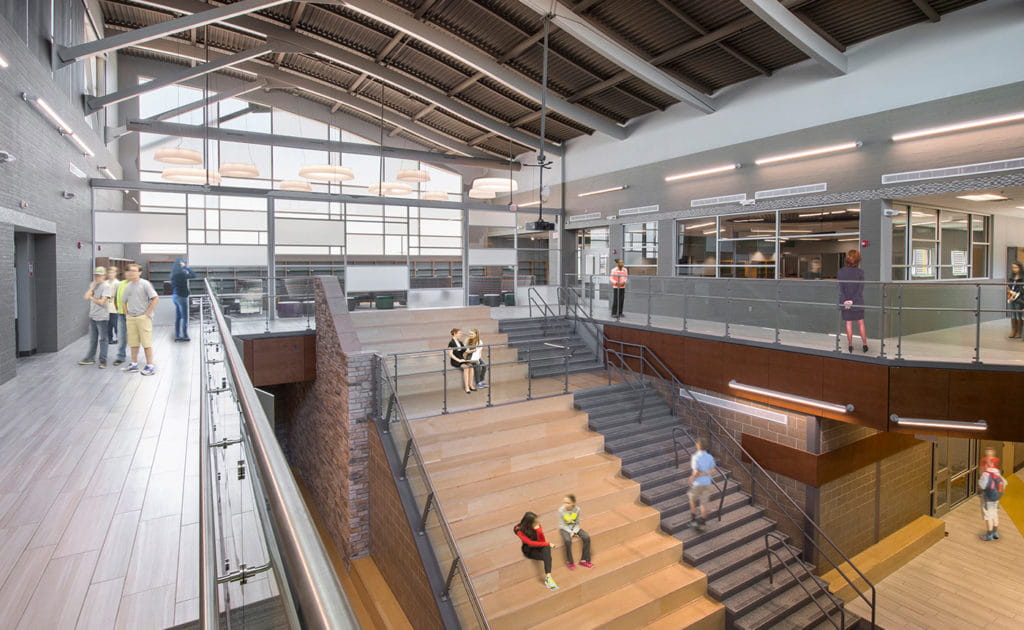Much is demanded of today’s schools, not just from the teachers and students within, but from the educational facilities themselves. Unique, flexible learning spaces are essential to provide modern students with the optimal learning environment. At the same time these buildings must be as cost-efficient as possible, to help cash-strapped school districts across the country cope with ongoing budget challenges and free up funds that can be apportioned elsewhere.
Creating learning environments that meet both these critical needs isn’t difficult, but for best results it does require an integrated, “whole building” approach throughout the design process, said Fred Schmidt, Senior Principal. That’s because many standard features that boost learning also allow for significant cost savings over the life cycle of the building, and this holds true both for new facilities and for renovations to existing schools.
When designing a school building – whether it’s a brand new facility or a renovation – FSB’s design team meets extensively with all stakeholders in the process, to obtain input from all perspectives and identify specific needs and concerns. “Energy efficiency is an offshoot advantage of the energy modeling we normally do when designing a healthy school, and we look at the overall design of the facility to find energy wasters,” Schmidt said. Once this data is obtained, “There are software systems packages we utilize that allow us to do energy modeling with shared information, so we can more effectively look at the energy usage,” Schmidt added. “Previously all we might have to go on were copies of the school’s utility bills or bills from comparable buildings in the area. Now that information is more accessible, so we can analyze the historic energy usage and the current usage and incorporate this information into our energy modeling. This allows us to achieve much greater accuracy in our energy cost estimations.”
The same factors which reduce a school’s energy operating costs overlap significantly with the factors that allow for peak student performance, namely thermal comfort and lighting, Schmidt said. The biggest challenges in these areas, they said, typically are classroom air circulation, dissipating heat that’s generated in the kitchen, and installing appropriate lighting throughout, especially in gymnasiums, restrooms, classrooms and parking lots. The envelope of a school building also must be taken into consideration, since windows are the greatest source of heat loss and heat gain in any structure, Schmidt noted. Installing thermal, low-E windows will provide one of the strongest weapons possible in the fight to lower a school’s operating costs.

“Research has shown that if students feel safe and physically comfortable, then they learn better,” Schmidt said. “That means everything from being safe from weather and outside intruders to maximizing personal comfort. If the building has the proper air changes, for example, with plenty of fresh air, no drafts, and a comfortable temperature, then they perform better. If your mechanical/electrical/plumbing systems aren’t at peak performance, then you can lose out on both energy savings and optimum student performance.”
One of the most effective trends in both school and commercial building design is that of “daylight harvesting” – the use of natural lighting alone or in combination with artificial lighting. The dual benefits of lower cost/improved performance are particularly visible in this key area, Schmidt noted. Multiple studies over the past several decades have linked natural lighting to improved school performance and fewer student behavioral problems.
On the energy savings front, classrooms and other spaces can be designed to maximize exposure to natural light. When renovating schools where fluorescent or incandescent lights are established, control systems can be upgraded and programmed to back off using these artificial lights when natural light is available. In either case, the result again is a significant lowering of utility costs. In existing spaces, the single greatest impact to cost savings and quality lighting is to replace older light fixtures with newer LED lighting, Schmidt said.
The use of automated building control systems to monitor HVAC functions is another design factor that has a major impact on both cost and comfort. A fresh wave of wireless technology and computer-networked, design-integrated controls make it possible to add multiple lighting control options that save money and are more flexible. These devices can independently perform such actions as controlling window openings for heat and fresh air control, and operating window shades for maximum heat control, so that they automatically adjust as the sun moves across a building. Boosting and lowering the ambient light provides a major savings in heat and cooling costs — funds that can potentially be used for other upgrades or desired building features.
For school officials who want to do more research, there’s also assistance available from the federal government, through programs such as the EPA’s ENERGY STAR for K-12 School Districts program, which provides technical support, guidance on financing options and recognition for schools that want to use energy more efficiently. (Program details are available at: https://www.energystar.gov/buildings.)
To learn more about how our cost-effective education facility design services can benefit your school district, contact Laure Majors at busdev@fsb-ae.com or (405) 840‑2931.